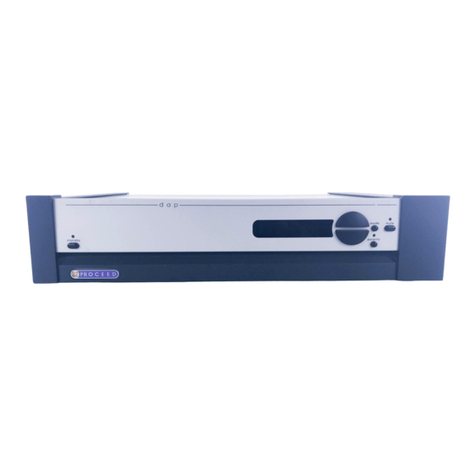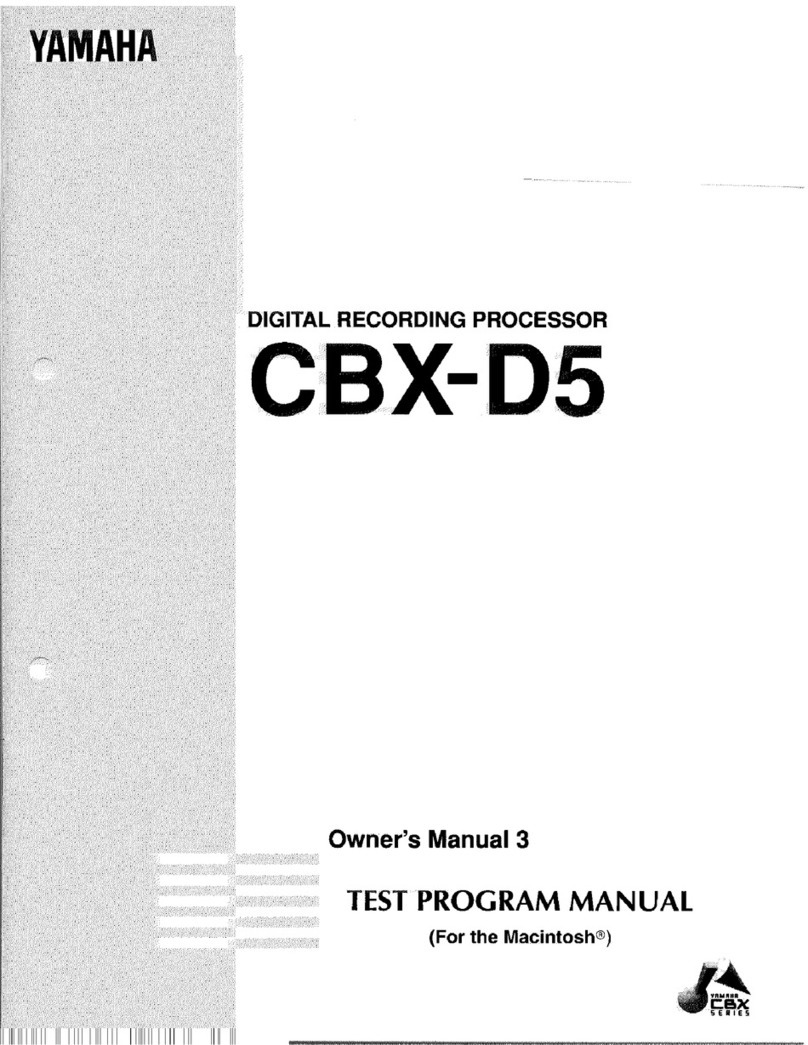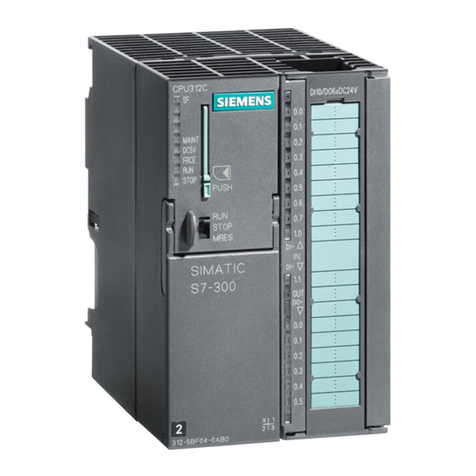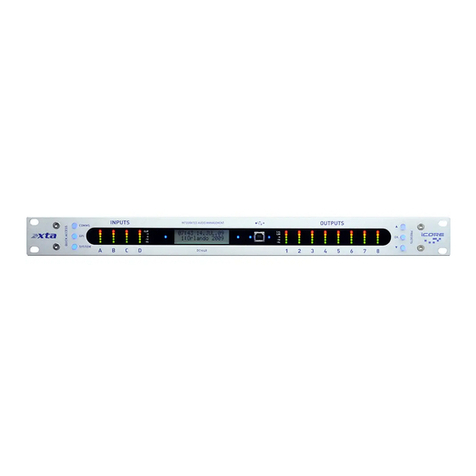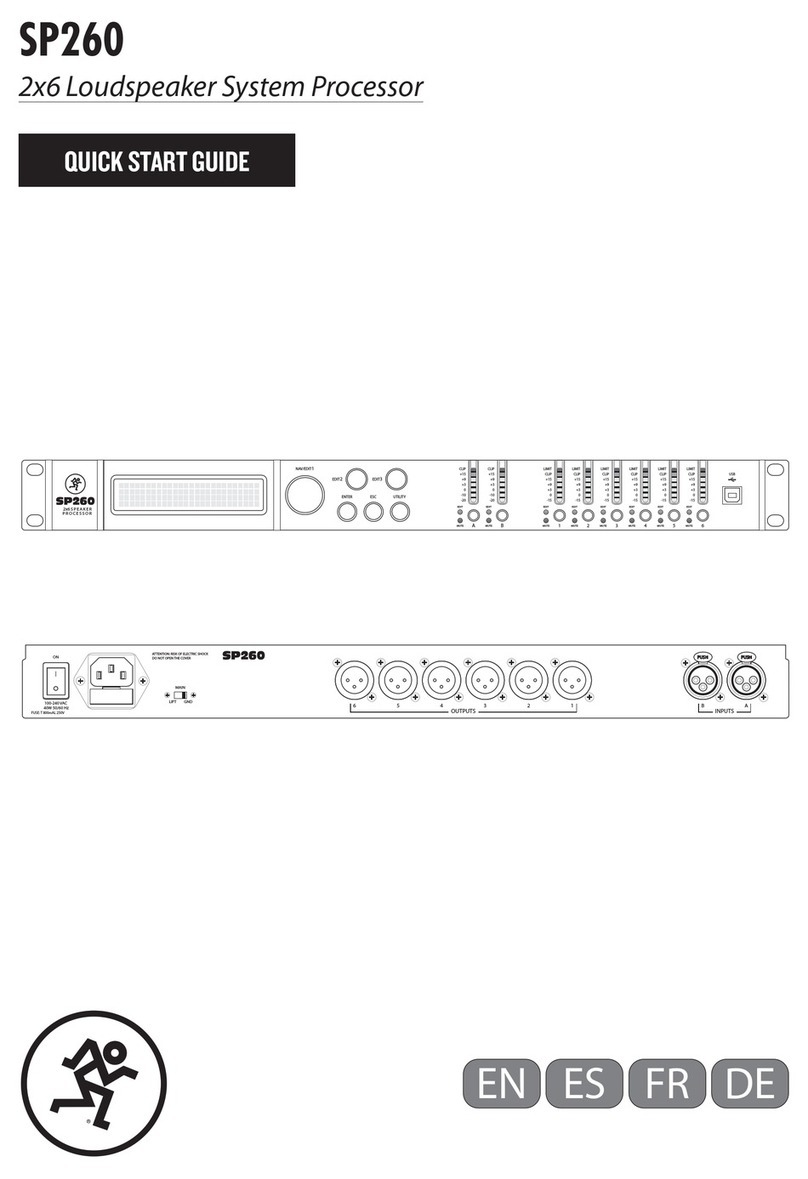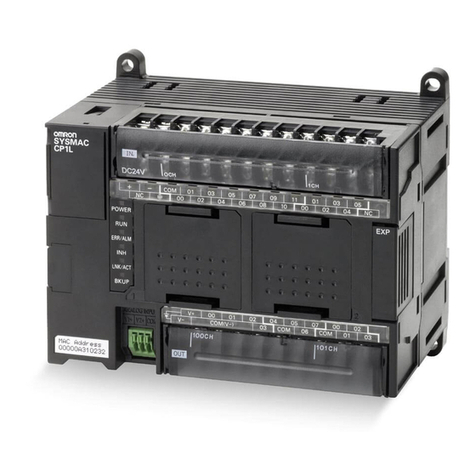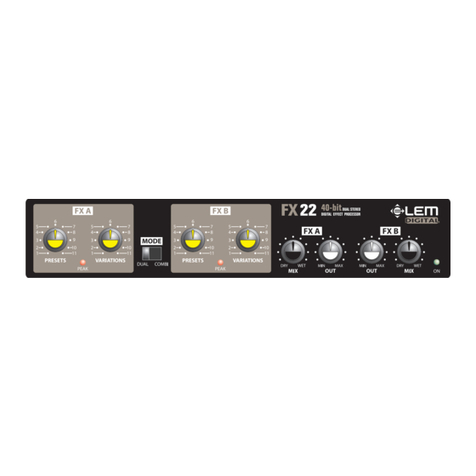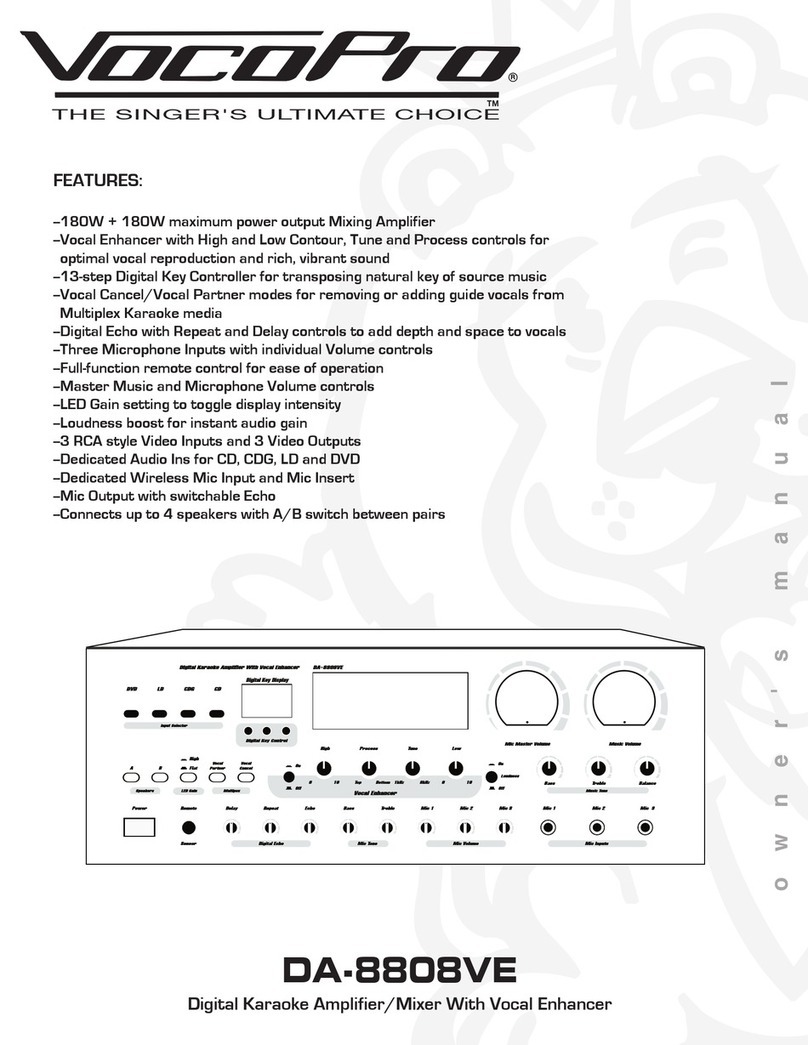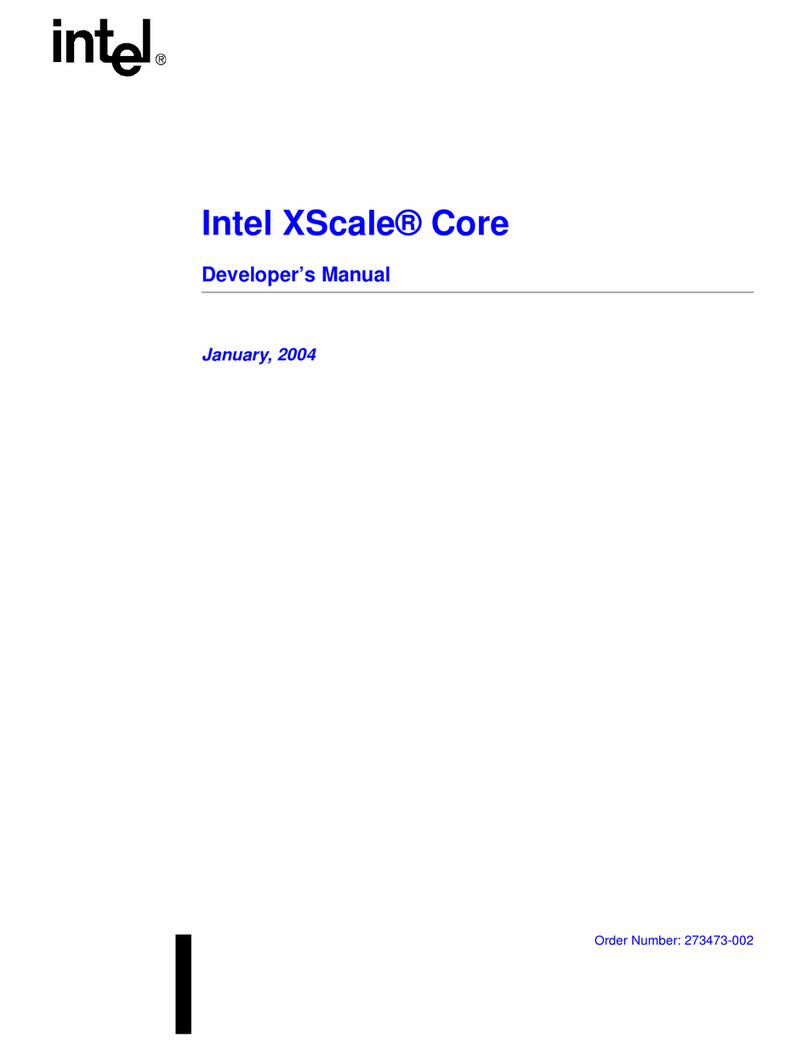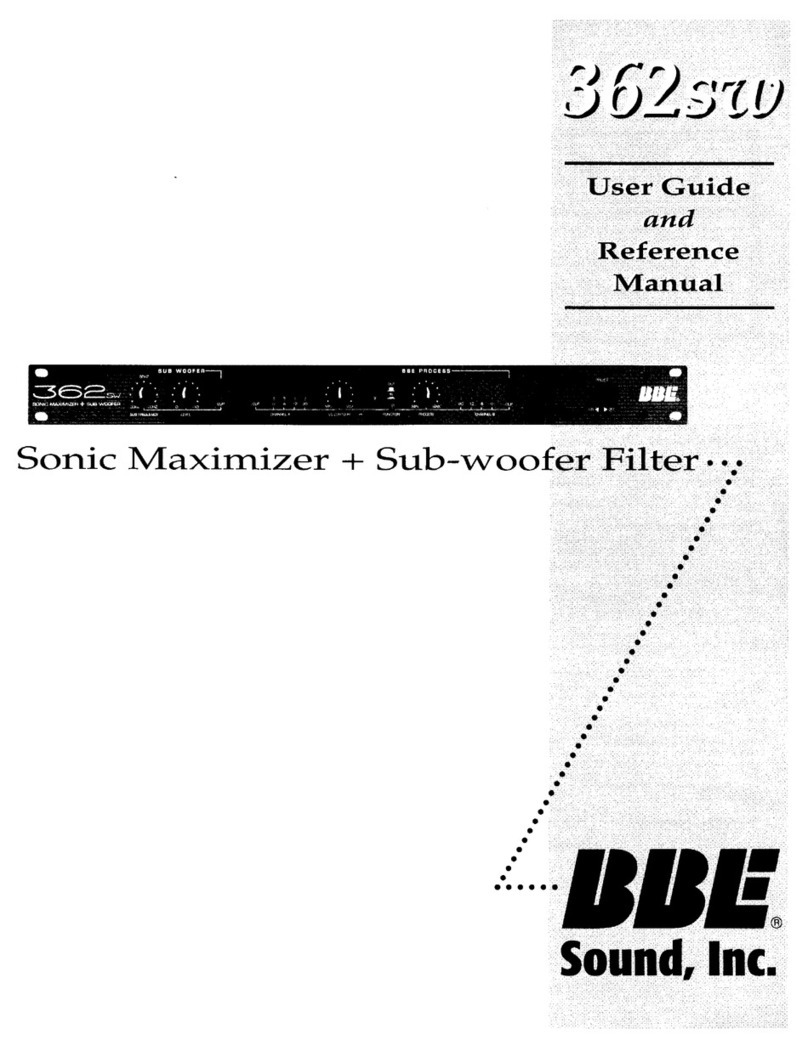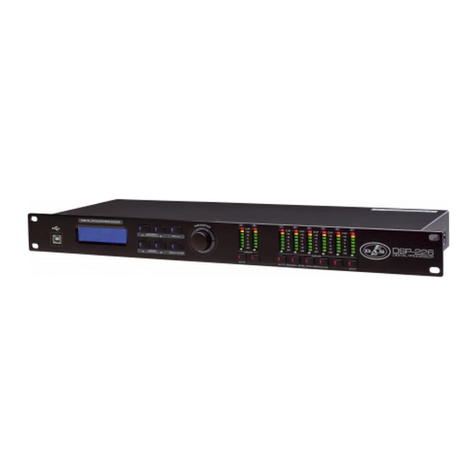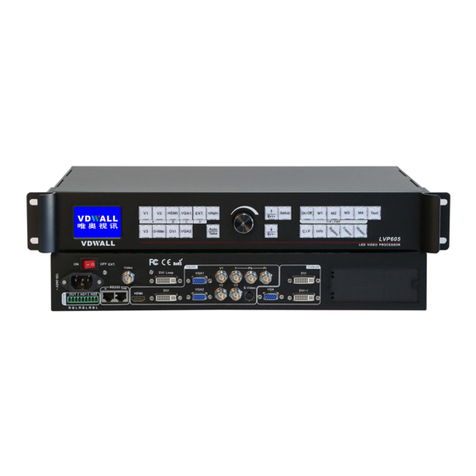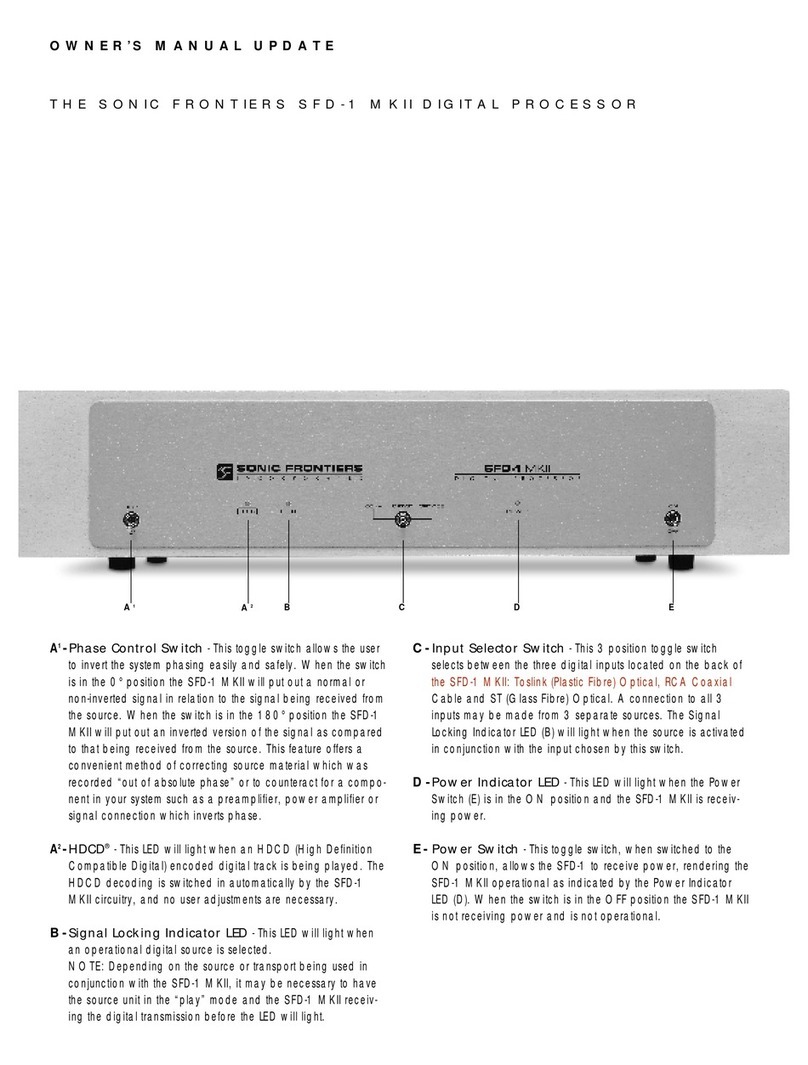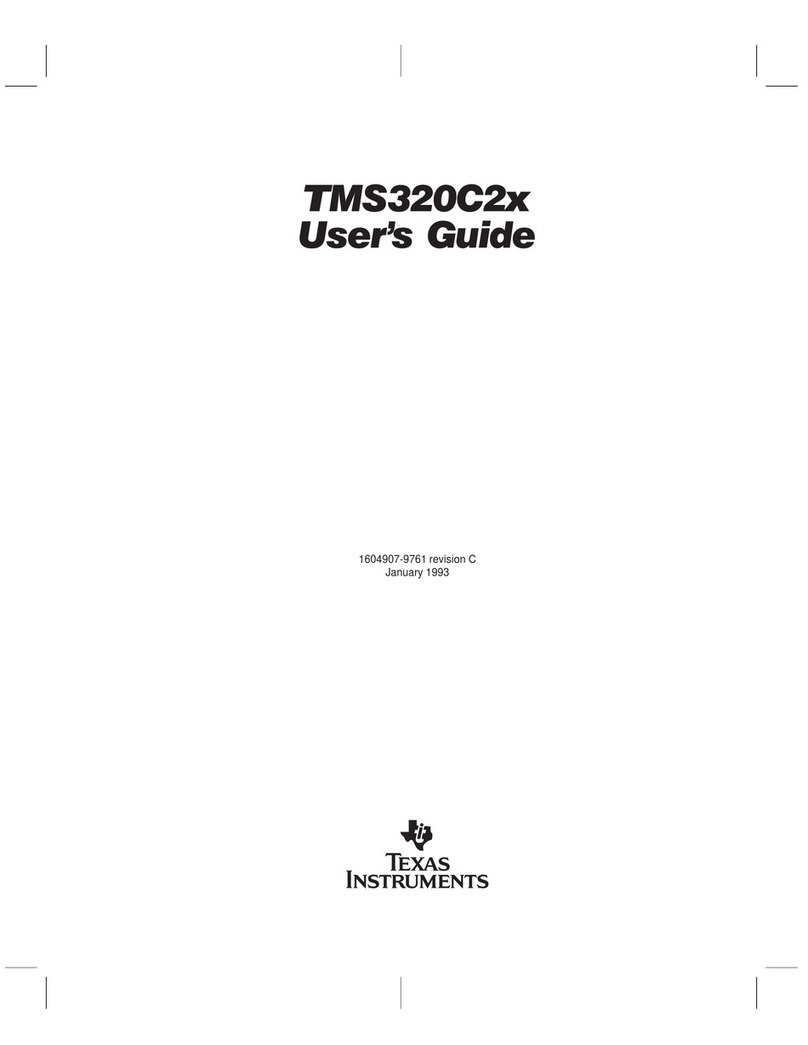Madrigal Audio Mark Levinson N 30.6 User manual

MadrigalAudioLaboratories,Inc.
OperatingManual
Mark Levinson®
Nº30.6
Reference Digital
Processor

CAUTION
RISK OF ELECTRIC SHOCK
DO NOT OPEN
CAUTION: TO REDUCE THE RISK OF ELECTRICAL SHOCK, DO
NOT REMOVE COVER. NO USER-SERVICEABLE PARTS INSIDE.
REFER SERVICING TO QUALIFIED PERSONNEL.
WARNING: TOREDUCETHERISKOFFIREORELECTRICSHOCK,DO
NOT EXPOSE THIS APPLIANCE TO RAIN OR MOISTURE.
NOTICE
This equipment has been tested and found to comply with the limits for a Class B digital device, pursuant to Part 15 of the
FCC Rules. These limits are designed to provide reasonable protection against harmful interference in a residential
installation. This equipment generates, uses and can radiate radio frequency energy and, if not installed and used in
accordance with the instructions, may cause harmful interference to radio communications. However, there is no guarantee
that interference will not occur in a particular installation. If this equipment does cause interference to radio or television
reception, which can be determined by turning the equipment on and off, the user is encouraged to try to correct the
interference by one or more of the following measures:
• Reorient or relocate the receiving antenna;
• Increase the separation between the equipment and the receiver;
• Connect the equipment into an outlet on a circuit different from that to which the receiver is connected;
• Consult the dealer or an experienced radio/TV technician for help.
CAUTION: Changes or modifications to this equipment not expressly approved by the manufacturer could void the user’s
authority to operate the equipment.
HDCD®and High Definition Compatible Digital®are registered trademarks of Pacific Microsonics, Inc.
The lightning flash with arrowhead symbol, within an equilateral triangle, is intended to
alert the user to the presence of uninsulated “dangerous voltage” within the product’s en-
closure that may be of sufficient magnitude to constitute a risk of electric shock to per-
sons.
The exclamation point within an equilateral triangle is intended to alert the user to the
presence of important operating and maintenance (servicing) instructions in the literature
accompanying the appliance.
Marking by the “CE” symbol (shown left) indicates compliance of this device with the EMC
(Electromagnetic Compatibility) and LVD (Low Voltage Directive) standards of the
European Community.
The information contained in the manual is subject to change without notice. The most current version of this manual will
be posted on our web site at http://www.madrigal.com.

ImportantSafetyInstructions
Please read all instructions and precautions carefully and completely before operating your Mark Levinson compo-
nent.
1. ALWAYS disconnect your entire system from the AC mains before connecting or disconnecting
any cables, or when cleaning any component.
2. This product is equipped with a three-conductor AC mains power cord which includes an earth
ground connection. To prevent shock hazard, all three connections must ALWAYS be used. If your
electrical outlets will not accept this type of plug, an adapter may be purchased. If an adapter is
necessary, be sure it is an approved type and is used properly, supplying an earth ground. If you
are not sure of the integrity of your home electrical system, contact a licensed electrician for assis-
tance.
3. AC extension cords are not recommended for use with this product. If an extension cord must be
used, be sure it is an approved type and has sufficient current-carrying capacity to power this
product.
4. NEVER use flammable or combustible chemicals for cleaning audio components.
5. NEVER operate this product with any covers removed.
6. NEVER wet the inside of this product with any liquid.
7. NEVER pour or spill liquids directly onto this unit.
8. NEVER block air flow through ventilation slots or heatsinks.
9. NEVER bypass any fuse.
10. NEVER replace any fuse with a value or type other than those specified.
11. NEVER attempt to repair this product. If a problem occurs, contact your Mark Levinson®retailer.
12. NEVER expose this product to extremely high or low temperatures.
13. NEVER operate this product in an explosive atmosphere.
14. ALWAYS keep electrical equipment out of the reach of children.
15. ALWAYS unplug sensitive electronic equipment during lightning storms.

4
From all of us at Madrigal Audio Laboratories, thank you for choosing the Mark
Levinson Nº30.6 Reference Digital Audio Processor.
A great deal of effort went into the design and construction of this precision de-
vice. Used properly, it will give you many years of enjoyment.

5
Table of Contents
UnpackingandPlacement ................................................................. 6
Unpacking the Nº30.6 ........................................................................................ 6
Placement of the Nº30.6.................................................................................... 6
OperatingVoltage .............................................................................. 7
AQuickStart… ................................................................................... 8
Warm up/break-in period .................................................................................9
SpecialDesign Features ..................................................................... 10
Powerful DSP Capabilities................................................................................ 10
24/96”capability & HDCD® ............................................................................ 10
An Intelligent FIFO™ ......................................................................................... 10
Superior isolation between sources ................................................................. 11
Fully balanced design ...................................................................................... 11
HDCD® Gain-Matching...................................................................... 12
Front panel,Nº30.6 ............................................................................. 13
Display,Nº30.6.................................................................................... 16
Rear panel,Nº30.6 ............................................................................. 18
Male XLR output connector (digital) ....................................................... 18
Linking connections .................................................................................. 19
Building link cables.................................................................................... 19
Female XLR input connector (digital)...................................................... 20
Male XLR output connector (digital) ........................................................21
Rear panel,PLS-330 .......................................................................... 22
AC power cord polarity............................................................................ 22
SetupandInstallation ....................................................................... 23
Nº30.6 Input Names.......................................................................................... 23
Making Digital Connections ............................................................................ 23
Making Analog Connections .......................................................................... 24
Making Link Connections ................................................................................ 24
Making Power Supply Connections................................................................ 25
Naming Your Inputs .......................................................................................... 25
Linkedfunctions ................................................................................. 27
Record link ........................................................................................................ 27
Standby link....................................................................................................... 27
Alias link............................................................................................................. 27
Play link ............................................................................................................. 27
Display Link ....................................................................................................... 27
Polarity link ........................................................................................................ 28
HDCD Link ......................................................................................................... 28
Troubleshooting................................................................................. 29
Careandmaintenance ..................................................................... 31
U.S.andCanadian Warranty............................................................... 32
90-Day Limited Warranty.................................................................................. 32
Five Year Extended Warranty........................................................................... 32
ObtainingService ............................................................................. 33
Specifications ................................................................................... 34
Dimensions ....................................................................................... 35
Nº30.6 Front Dimensions ............................................................................ 35
Nº30.6 Rear Dimensions ............................................................................ 35
Nº30.6 Top Dimensions .............................................................................. 36
PLS-330 Front Dimensions .......................................................................... 36
PLS-330 Rear Dimensions ..........................................................................36
PLS-330 Top Dimensions ............................................................................ 37

6
Unpacking and Placement
Unpacking the Nº30.6 Unpack your Nº30.6 Reference Digital Processor and PLS-330 Power Supply and
remove all accessories from the cartons. Keep all packing materials for future
transport.
Included with your new Mark Levinson processor is a pair of knit, white gloves
designed to assist you in the initial unpacking and placement of your new pur-
chase. Please accept them as a token of our appreciation for having purchased
one of our products.
Placement of the Nº30.6 The Nº30.6 should be placed as close as possible to your digital source equip-
ment, thus keeping interconnect cabling short. We strongly recommend shelf
mounting to allow for proper ventilation. The Nº30.6 is designed for continuous
operation, which is why it features a standby mode rather than a full “off”
mode—it is designed to be connected to the AC mains at all times for the best
performance.
Three DC cables are provided to connect the PLS-330 to the Nº30.6. Their lengths
allow you to place the PLS-330 so that it won’t induce hum in the Nº30.6 and
other sensitive components. (The best location for the PLS-330 is often near the
floor, since it does not require any day to day user interaction). Other associated
equipment should also be placed so that it doesn’t induce hum in the Nº30.6 and
other sensitive components.
Be sure to allow 3 to 4 inches of clearance above both the Nº30.6 and the PLS-
330, to allow heat dissipation through air circulation.
Drawings are included in this manual to facilitate special installations and custom
cabinetry (see “Dimensions”).

7
Operating Voltage
The PLS-330 is set at the factory (internally) for 100V, 120V, 220V, 230V, or 240V AC
mains operation at either 50 or 60Hz. (230V/50Hz only in European Union coun-
tries, in compliance with CE regulations.) This voltage setting cannot be changed
by the user. Make sure that the label on the rear panel of the PLS-330 (above the
AC cord) indicates the correct AC operating voltage for your location.
If the voltage indicated on your PLS-330 is incorrect, or if you wish to change the
AC operating voltage of your Nº30.6/PLS-330 as the result of moving to a different
country than the one in which you purchased your digital audio processor, see
your Mark Levinson dealer.
The Nº30.6/PLS-330 can be powered by a normal 15-ampere AC mains line. If
other devices are also powered from the same AC line, their additional power
consumption should be taken into account.
For optimal sonic performance and longevity, the Nº30.6 is designed to remain
powered at all times (the standby switch merely mutes the processor’s outputs
and turns off the display). There is an initial break-in period of approximately
300 hours before the Nº30.6 achieves optimum performance.

8
A Quick Start…
We recognize that many people are understandably eager to begin listening to
their new components, and that reading the manual is often done (if at all) at a
later time—perhaps while listening to music through the new product itself. We
strongly recommend that you read this manual thoroughly, as the Nº30.6 Refer-
ence Digital Audio Processor incorporates several unusual features which en-
hance its operation.
Fortunately, we can help you get some music up and running on your system
quickly, so that you may begin enjoying your new digital to analog converter
while reading more about it. The goal here is simply to make some music as
quickly as possible.
The following procedure assumes that the rest of your system is already con-
nected (e.g., preamplifier to power amplifier, to speakers, etc.).
1 TURN OFF YOUR ASSOCIATED COMPONENTS
This minimizes the opportunity for a momentary electrical surge disturbing
your system while making connections. If you have a large power amplifier,
allow its power supply to fully discharge before proceeding (which may
take as long as several minutes).
2 CONNECT A DIGITAL SOURCE TO EITHER INPUT 1 OR 5
Inputs 1 and 5 on the Nº30.6 are configured from the factory for CD trans-
ports, the most common type of digital transport. Input 1 is an AES/EBU
(XLR-type) digital input; Input 5 is an S/PDIF (RCA-type) digital input. These
digital inputs are found on the rear of the center section of the Nº30.6. Use
high quality digital cable such as Madrigal MDC-1 for XLR-type, or MDC-2
for RCA-type connections.
3 CONNECT A SET OF ANALOG OUTPUTS TO YOUR PREAMPLIFIER
The Nº30.6 has two identical sets of balanced (XLR) analog outputs and
one set of single-ended (RCA) outputs. They are found on the two towers
(which house the analog circuitry). As viewed from the front, the left tower
contains the Left channel and the right tower contains the Right channel.
Use high quality cable such as Madrigal CZ Gel.
4 CONNECT THE POWER SUPPLY LEADS FROM THE PLS-330 TO THE Nº30.6
There are three power supply leads which run from the rear of the PLS-330
to the rear of the Nº30.6. The analog DC cables for the left channel and the
right channel towers use special five-pin connectors on both ends. The digi-
tal DC cable for the center section uses a two conductor connector at each
end. These cables are not directional.

9
5 CONNECTTHE AC CORD TO THE PLS-330 AND TO YOUR AC OUTLET
The AC recepticle for the power cord is located underneath the PLS-330, in
the center of the unit. (This design reduces noise by bringing the power
into the chassis precisely where it is needed, rather than routing it through-
out the unit.) The Nº30.6 will take a few moments to initialize and will then
be ready to use.
6 SELECT THE INPUT YOU ARE USING BY PRESSING ITS FRONT PANEL BUT-
TON
7 TURN ON THE OTHER COMPONENTS; SLOWLY RAISE THE VOLUME
Congratulations! You should now be able to enjoy your favorite music while
reading the rest of this manual.
Warm up/break-in period Although your Mark Levinson Nº30.6 digital processor delivers outstanding perfor-
mance straight out of the box, you should expect to hear it continue to improve
as it reaches its normal operating temperatures and its various components
“break-in.” It has been out experience that the greatest changes occur within the
first 25-50 hours, but that the Nº30.6 will continue to improve in sound quality for
about 300 hours, after which time it remains quite constant.
The only exception to this rule is if power is removed from the unit for an ex-
tended period, allowing it to cool down. In this case you should expect a brief
warm-up period before the Nº30.6’s sound quality is at its best.

10
Special Design Features
Congratulations on your purchase of the Nº30.6 Reference Digital Audio Processor.
The Madrigal design team is confident you will enjoy the outstanding perfor-
mance of the Nº30.6 for many years. In case you are interested in technical de-
tails, what follows is a brief outline of some of the key technologies in your new
processor.
Powerful DSP Capabilities Your Nº30.6 employs four powerful SHARC®digital signal processors to deliver
exceptional flexibility and versatility. Together, they form a single DSP “engine” that
can handle the myriad of processing duties required in today’s rapidly-changing
world of digital audio. These duties include decoding HDCD™and “24/96” de-
coding, and may be expanded to include many other signal formats over time.
“24/96” capability & HDCD®In addition to the common 16 bit at either 44.1 and 48 kHz sampling rates used
by digital sources such as CD and DAT, your Nº30.6 also supports the two chan-
nel 24-bit/96 kHz signal that was defined as part of the DVD-Video standard
(and which will certainly be included as part of a larger DVD-Audio standard
when the industry agrees to such a thing). As of the writing of this manual, such
“24/96” material is just beginning to become available, and we expect availability
to grow quickly over time.
In addition to true 24-bit capability, the Nº30.6 also incorporates High Definition
Compatible Digital®decoding to take full advantage of the increased resolution
available from HDCD-encoded 16-bit CDs. The High Definition Compatible Digi-
tal®format retains much of the resolution inherent in professional twenty bit re-
cordings, by encoding this information more efficiently within the sixteen bit
space available within the Compact Disc format.
An Intelligent FIFO™ Unlike previous processors which were highly dependent on the quality of the
digital signal they were fed, the Nº30.6 Reference Digital Audio Processor delivers
outstanding performance with even less-than-ideal digital signals.
“FIFO” stands for “First In, First Out.” It describes a simple buffer in which the
digital information is stored temporarily on its way to being converted to analog.
Just as a large water tower can provide a steady source of water to a small town,
despite hour-to-hour variations in the supply of water from the well, a FIFO can
provide a steady, consistent source of digital data to the converters which are re-
sponsible for changing that data into music. Even if there is significant “jitter” (in-
consistencies in timing) in the incoming digital information, the output of the
FIFO is controlled by a special clock with tremendous accuracy. The result largely
eliminates the jitter and allows the musical information to be reproduced cleanly,
without jitter-induced distortions.
The trouble with most FIFOs lies in their behavior when the incoming signal is
poor enough to cause the “water tank” to overflow or to be emptied. Normally, a
FIFO would then have to “invent” false data to fill the gap, throw away excess
data, or revert to non-FIFO operation. None of these approaches are acceptable.
Of course, you could simply use an extremely large buffer. Unfortunately, this so-
lution is a poor one.

11
A larger buffer implies a longer delay between when information goes in and
when it starts coming back out. With laserdiscs, for example, you must keep the
in/out delay small so as to keep the soundtrack synchronized with the picture on
the screen. An oversized buffer would make every movie’s audio out of step with
its video, an unacceptable situation. It is possible to bypass the FIFO for movies,
but you then lose all of its distortion-reducing benefits.
Madrigal engineers have developed a proprietary buffer management scheme
which reduces reproduced jitter to less than 20 picoseconds while maintaining
the synchronization of sound and picture in movies. It employs a buffer large
enough to absorb the jitter found in transports of reasonable quality, yet small
enough to have impreceptible delay. The rate at which data is released from the
FIFO buffer is controlled by software to track the long-term data rate of the in-
coming signal, allowing the buffer to absorb all the short-term variations which
cause sonic degradation. This approach yields a “smart” FIFO buffering scheme
which rejects virtually all incoming jitter without requiring an enormous buffer
and the consequent audible delay. It also avoids the sonic penalties associated
with the usual strategies used when a buffer overflows or empties.
The Intelligent FIFO operates at all sampling rates, improving the quality of every
connected digital source component.
Superior isolation
between sources One of the advantages of a separate digital audio processor is that you can take
the money which might have otherwise been spent on several built-in D/A con-
verters and put it into one, superior processor which will enhance the perfor-
mance of all the transports with which it is used. Ironically, many outboard pro-
cessors fail to live up to this potential due to interference between their various
digital inputs.
The Nº30.6 provides outstanding isolation between its inputs, realizing the full
potential of the various digital transports with which it is used. In fact, every
source has its own dedicated digital interface receiver. As a result, the selected
input effectively has the Nº30.6 “all to itself” for its conversion to analog.
Fully balanced design The Nº30.6 is fully balanced in both the analog and digital domains. All digital
filtering and processing is implemented in a balanced configuration, and conver-
sion to analog is accomplished in two opposing polarity 24-bit converters per
channel.
This approach maintains the integrity of the signal, reducing the opportunities for
music-destroying noise and digital artifacts to enter the signal path.
We strongly recommend the use of quality balanced interconnects such as
Madrigal’s CZ Gel-1 for the best performance. The improvements are both mea-
surable and readily audible.

12
HDCD®Gain-Matching
Some HDCD-encoded recordings are mastered at a level which is noticeably lower
(6 dB) than conventional recordings, to allow for greater dynamic peaks. To avoid
unexpected changes in average volume when going from one disc to another, the
Nº30.6 can automatically reduce the volume of all recordings by six decibels. To re-
mind you of of when it is in this mode of operation, the Nº30.6 will display the
input’s name and “6 dB PAD” when locking on a digital input signal in the HDCD
AUTO mode.
In our listening tests, we have determined that the only sonically transparent gain-
matching technique is to raise the volume of the preamplifier by the requisite 6 dB
when playing those few discs that require it. All other design options introduce
acompromiseinsoundqu ality.
For Best Performance: We strongly recommend that you use the HDCD MANUAL gain-
matching in your Nº30.6 digital audio processor.
If youare u sing the Nº30.6with a Mark Levinson preamplifier, simply name
the appropriate input on the preamplifier “No30” (explained in the preamp manual),
and connect the two products with a Communications Link cable. In this case, the
Nº30.6 will tell the preamplifier to change its volume setting as necessary to com-
pensate for differing CD mastering techniques, and you never have to think about it.
(The preamp’s display will show “HD+6” to indicate a change required by the HDCD
recording being played through the Nº360S; it will revert to normal and show
“HD+0” when you return to conventional recordings. Older Nº38 and Nº38S pream-
plifiers may require a new EPROM to take advantage of this feature.) This technique
ensures that you always get the best possible sound from your system, without any
unexpected changes in level, regardless of the recordings you play.
Ifyouare u singthe Nº30.6with any otherpreamplifier,follow the steps be-
low. (You will have to adjust the volume on some HDCD recordings manually.)
1 PRESS AND HOLD THE DIGITAL RECORD SELECT BUTTON ONTHE FRONT
PANEL
After a few seconds, the display will change to show NAME= and the current
name of the selected input. When you let go, it will still show NAME= and the
current name of the input. (Ignore this for now.You’ll learn how to rename
your inputs to match your sources later on in this manual.)
2 PRESS THE POLARITY BUTTON SOTHE DISPLAY SHOWS “HDCD MANUAL”
Repeatedly pressing the polarity button will toggle the display between “HDCD
AUTO” (meaning that the Nº360S automatically lowers its volume on conven-
tionally-mastered discs) and “HDCD MANUAL” (meaning that gain-matching is
turned off; HDCD-encoded discs will still be decoded properly). If you try to
change from one to the other while a Nº380 is Linked, the Nº30.6 will display
“No38 ACTIVE!” (indicating that the equipment already knows what to do).
Using manual gain-matching ensures that the HDCD digital filter always operates
at its maximum resolution, although you may now have to manually turn up the
volume on some HDCD recordings, beyond your usual settings.

13
display
intensity
copy protect aes/ebu emphasis
digital record
select
polarity
invert 12345678 standby
REFERENCE DIGITAL
PROCESSOR
Nº 30.6
5
37 89
4
10
6
1
MADRIGALAUDIO LABORATORIES
2
Front panel, Nº30.6
1STANDBY
Provided the Nº30.6 is connected to AC power (via the PLS-330), pressing
this button takes the Nº30.6 out of “standby” mode, turns the display on,
and enables the front-panel controls.
Pressing standby again places the Nº30.6 into standby mode, turns the dis-
play off, turns off all outputs (including the record outputs), and disables
the front-panel controls.
2 STANDBY LED
While the Nº30.6 is in standby mode, this LED flashes approximately every
five seconds. When the Nº30.6 is ready to operate (that is, when it is not in
standby mode), this LED remains lit.
3 SOURCE SELECTION BUTTONS
Pressing these buttons selects the digital source, according to the input con-
nections on the rear panel (see “Rear panel, Nº30.6”). Only one source at a
time may be selected.
When power is first applied to the Nº30.6 (or when power is restored after
an interruption), it will search for and select the first input with an active
digital signal. If none is found, it will select the first named source. As deliv-
ered from the factory, this input will be “CD1.”
When the Nº30.6 is taken out of standby mode, the source last selected be-
fore going into standby will be automatically selected.
4 DISPLAY
See “Display, Nº30.6” beginning on page 16.

14
5DISPLAYINTENSITY
Pressing this button varies the brightness of the display. Four brightness lev-
els are available.
When power is first applied to the Nº30.6 (or when power is restored after
an interruption), the display is automatically set to its brightest level.
Pressing the display intensity button once dims the display one level;
pressing it again dims it further; pressing it again turns the display off.
Pressing display intensity once more returns the display to its brightest
level.
6 DIGITAL RECORD SELECT
Pressing digital record select button allows you to select the digital source
you want to record to your digital recorder. It is possible to record a differ-
ent digital source than the one selected for listening.
To record a digital source connected to the Nº30.6, press digital record se-
lect. The Nº30.6’s display will show RECORD followed by the source cur-
rently selected. For example:
If you want to record a different source than the one currently selected,
press the corresponding source selection button; the display will then show
the input number of that source (for example, RECORD CD2).
To disable the record output, press the button again for the source which is
currently selected to be recorded. The display will read RECORD OFF and
the digital output of the Nº30.6 will be temporarily disabled, eliminating any
potential interaction between the record output circuitry of the Nº30.6 and
the rest of your system. Repeatedly pressing the button for the currently se-
lected recording source will toggle the Nº30.6 between RECORD OFF and
that source.
After a few seconds, the Display will return to normal.
Caution! When using a digital recorder (like a DAT) that also allows
recording of analog signals, a specific combination of
interconnections and settings on the digital recorder, the
Nº30.6, and an associated preamplifier may create a
“feedback loop” that may damage your system’s
loudspeakers. For guidance in avoiding such a feedback
loop, consult your Mark Levinson dealer.

15
7 POLARITY INVERT
Pressing this button inverts the polarity of the digital signal, to compensate
for polarity differences during the recording process. Some recordings may
simply “sound better” when this function is active.
While polarity invert is selected, the LED above the button will light.
Note:polarity invert doesn’t affect the digital outputs, and isn’t available
for inverting the polarity of digital signals to be recorded.
Note:polarity invert may be operated by infrared remote control, but
only when the Nº30.6 is connected to compatible Mark Levinson
components such as the Nº31.5 Reference CD Transport. Com-
plete instructions are included in those components’ operating
manuals.
8 COPY PROTECT LED
This LED lights when the Nº30.6 detects encoded copy protection in the
digital program being processed.
9 AES/EBU LED
The aes/ebu LED lights when the Nº30.6 detects that the digital program
being processed conforms to the AES/EBU (Audio Engineering Society/Euro-
pean Broadcast Union) professional standard. This LED indicates the pres-
ence or absence of certain encoded information in the digital signal. It does
not indicate that the AES/EBU connections (a connection standard written by
the same group) are being used. Playback of non-AES/EBU CDs or DATs
won’t activate the aes/ebu LED, even if the associated transport is con-
nected according to the AES/EBU standard
10 EMPHASIS LED
The compact disc standard, as created by Sony and Philips, allows a high-
frequency boost to be employed during recording. This boost, called re-
cording pre-emphasis, increases the signal-to-noise ratio at high frequencies,
but must be countered by a high-frequency cut before playback to restore a
recording’s normal frequency response. De-emphasis may be done as the
recording is being mastered, or the compact disc (or digital audio tape)
may be made with the pre-emphasis still on, and the de-emphasis per-
formed in the playback unit.
In the Nº30.6, the de-emphasis filtering is done in the digital domain.
The emphasis LED lights when the Nº30.6 detects recording pre-emphasis
in the digital program being processed, and subsequently employs its de-
emphasis circuitry (see “Specifications”).
Note: The de-emphasis circuitry of the Nº30.6 is designed to be
compatible with all known digital standards. However, it is
possible for the emphasis LED to light in error when there is
no disc being played. This is not a malfunction of the Nº30.6.
Rather, it is the result of the transport generating ambiguous
signals in the absence of a spinning disc to read. You may
never see this condition. Even when the condition exists, it
has no effect on sonic quality, as it can only occur when
there is no disc playing.

16
Display, Nº30.6
1INPUTALIAS
This part of the Nº30.6’s display shows the name of the input selected, as
determined during setup (see “Assigning input names” in the “Installation”
section of this manual).
To facilitate operation in complex, multi-source systems, the Nº30.6 is ca-
pable of displaying a wide variety of names for each of its eight inputs.
They are listed below.
NOT USED (any unused input)
CD Compact Disc
DVD Digital Video (or “Versatile”) Disc
LD Laser Disc
DAT Digital Audio Tape
DCC Digital Compact Cassette
MD Mini Disc
CDR Compact Disc, Recordable
CDI Compact Disc, Interactive
DBS Direct Broadcast Satellite
DSS Digital Satellite System (“DirecTV” or “USSB”)
AUX Auxiliary (other digital sources)
DCR Digital Cable Radio
2 INPUT NUMBER
This part of the Nº30.6’s display shows the input number of the selected
digital source, according to the connections on the rear panel (see “Rear
panel, Nº30.6”).
1 2 3

17
3 SAMPLING FREQUENCY
This part of the Nº30.6’s display shows the sampling frequency of the digi-
tal input being processed, expressed in kilohertz (kHz). One of five sam-
pling frequencies will be shown: 32kHz, 44.1kHz, 48kHz, 88.2kHz, 96kHz.
After you press one of the source selection buttons, the Nº30.6 will reduce
the volume and the display will show:
While the Nº30.6 is attempting to lock onto a digital signal, the display will
show:
If no digital signal is present (if the source is turned off, is improperly con-
nected, or is disconnected), the display will show:

18
PUSH PUSH PUSH
right channel
analog output
balanced analog
output
analog dc in
left channel
analog output
balanced analog
output
analog dc in
digital
dc in 1 2 3 4 5 6 7 8
digital inputs
master RS-232
electrical
digital outputs
optical
electrical
rec monitor rec
optical
balanced analog
output balanced analog
output
communication
ports
control ports
PHASTLink® compatible REFERENCE DIGITAL PROCESSOR Nº30.6
designed and manufactured in U.S.A.
by MADRIGAL S/N
4 45 6 7 10 11 12
2
1
8 9
3
Rear panel, Nº30.6
1 SINGLE-ENDED ANALOG OUT
These outputs provide single-ended line-level analog audio (via cables
equipped with RCA-type connectors) to a preamplifier, integrated amplifier,
or receiver.
2 BALANCED ANALOG OUTPUTS
These outputs provide balanced line-level analog audio (via cables
equipped with XLR-type connectors) to a preamplifier, integrated amplifier,
or receiver equipped with balanced inputs (see “Set-up and installation”).
The pin assignments used are AES-standard, as shown below:
Male XLR output
connector (digital)
12
3
Pin 1: signal ground
Pin 2: non-inverting signal
Pin 3: inverting signal
Connector ground lug: chassis ground
3 PHASTLINK®CONTROL PORTS
In addition to the Mark Levinson Linking system described above, the
Nº30.6 can, as an extra-cost option, support the PHASTLink®communica-
tions system. This system is designed to facilitate complete systems integra-
tion with PHAST®controllers. For more information on PHAST®(a division
of AMX®), please refer to the internet at http://www.phast.com.
4 ANALOG DC IN
These inputs, one for each channel, accept DC power from the PLS-330 (via
the supplied cables equipped with five-pin connectors).

19
Connect the left channel’s analog dc in on the rear panel of the Nº30.6 to
the left analog dc out on the rear panel of the PLS-330; likewise, connect
the right channel’s analog dc in on the rear panel of the Nº30.6 to the right
analog dc out on the rear panel of the PLS-330.
5 COMMUNICATION PORTS
Your Nº30.6 includes both RS-232 and the Mark Levinson Linking system
communications ports.
The RS-232 port may also be used to update the operating software of the
Nº30.6, so that your system will be able to handle new digital audio formats
as they are introduced. (Think of updating the software in the Nº30.6 as
being like installing new software in your computer… only much less pain-
ful.) Once again, your dealer can assist you in taking advantage of these
advanced features, should the need arise.
The “pinout” connections used on the RJ-11 connector used for the RS-232
port is as follows:
control
in out 232 ir
input
1 2
DC
triggers
123456
pin 2 = Rx from PC
pin 3 = Tx to PC
pin 5 = ground
Note that only qualified technicians should attempt to make use of the spe-
cial capabilities afforded by this RS-232 communications port.
Linking connections
The Mark Levinson Linking system uses the Nº30.6 as the Master of (and
central clearinghouse for) inter-component communications. Other compo-
nents such as digital transports are connected to the Master as “Slaves,” and
can be “daisy-chained” using their Slave In and Slave Out jacks. As the ulti-
mate destination of all source signals, the Nº38 or Nº38S Preamplifier (if
owned) must be the final “Slave” in the chain. (In technical terms, it termi-
nates the communications bus.) In turn, the Nº38 can serve as a master to
an associated compatible Mark Levinson power amplifier—hence its “Mas-
ter” communications port.
Thus, if the only other Mark Levinson Link-compatible component you
have is the preamplifier, connect the Nº30.6’s master port to the
preamplifier’s slave port using a “straight-through” RJ-45 cable. If there are
additional Mark Levinson Link-compatible components in the system, place
the preamplifier at the end of the chain by connecting the last slave out
port to the Nº38’s slave port. See the diagram at left for clarification.
The RJ-45 cable needed for the Link connection between the Nº30.6 and
other Link components may be purchased from your Mark Levinson dealer.
It may also be made to length using two RJ-45 connectors and the appro-
priate length (up to 100 feet/30 meters) of RJ-45 (flat, eight conductor)
cable.
digital output
digital inputs
slave in
master
slave out
Link
cable
digital output slave in
Nº30.6
Link
cable
slave out
slave
Link
cable
analog output
any input
Audio
connections
Nº31.5
Nº31.5
Nº380S

20
RJ-45 cables and connectors are used throughout the world for both tele-
communications and computers, and are widely available. The connectors
are crimped on to the ends of the cable such that pin 1 at one end is con-
nected to pin 1 at the other end. Such a “straight-through” connection is
(counter-intuitively) made by introducing a 180°twist in the cable between
the two ends, as shown below.
Building link cables
From Nº30.6 To Nº31.5
Locking tabLocking tab
Connecting the communication ports other than as
described in this manual will damage the Nº38 and the
associated Mark Levinson components, and will void those
products’ warranties.
6 DIGITAL DC IN
This input accepts DC power from the PLS-330 (via the supplied cable
equipped with two-pin connectors).
Connect digital dc in on the rear panel of the Nº30.6 to the digital dc out
on the rear panel of the PLS-330.
7 AES/EBU ELECTRICAL DIGITAL INPUTS (1– 3)
These inputs accept the digital audio signal (DAS), via cables equipped
with XLR-type connectors, from digital sources such as a compact disc
transport, laser disc transport, digital audio tape transport, digital broadcast
receiver.
These inputs conform to the AES/EBU digital interconnection standard, which
calls for a 110Ωtransmission of the DAS. Use a digital interconnecting cable
specifically designed for the 110ΩAES/EBU standard, such as Madrigal MDC-1
cable, when using these inputs. The pin assignments for the AES/EBU digital
interconnection standard are shown below.
Female XLR input
connector (digital)
PUSH
21
3
Pin 1: chassis ground
Pin 2: non-inverted DAS
Pin 3: inverted DAS
Connector ground lug: chassis ground
8 S/PDIF RCA ELECTRICAL DIGITAL INPUTS (4 – 5)
These inputs accept the digital audio signal (DAS), via cables equipped
with XLR-type connectors, from digital sources such as a compact disc
transport, laser disc transport, digital audio tape transport, digital broadcast
receiver.
Table of contents
Other Madrigal Audio Processor manuals
